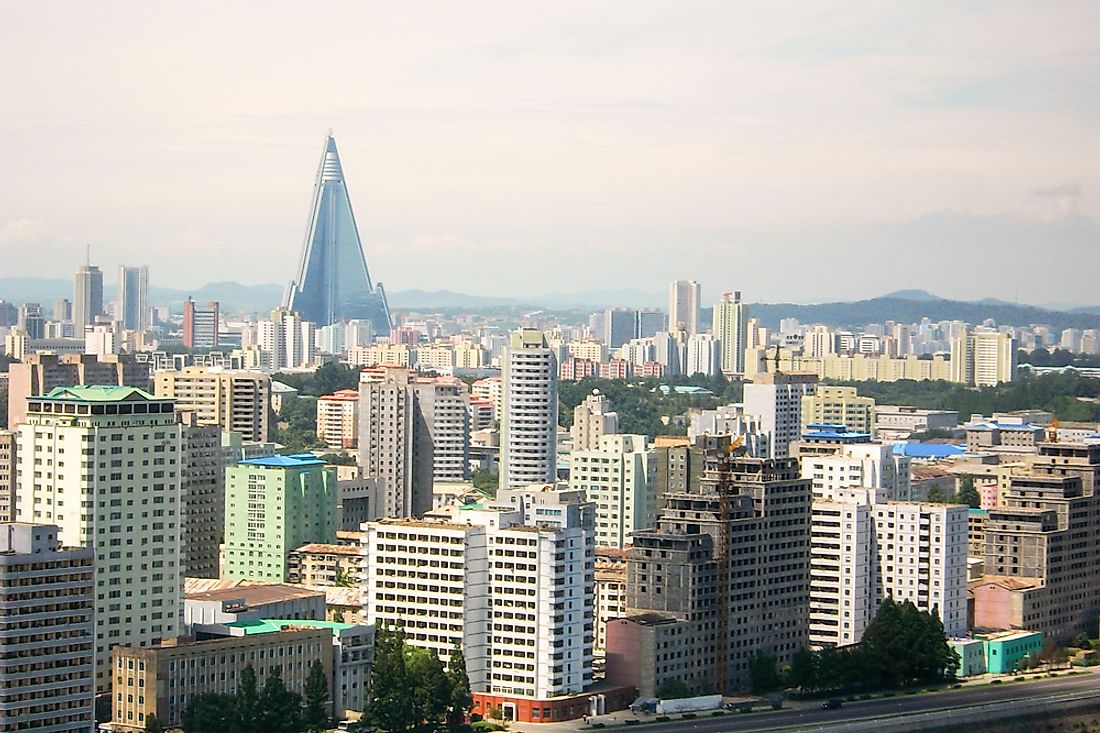Biggest Cities In North Korea

North Korea is an urbanized country, with 56% of its population living in urban areas. Rapid urbanization was experienced between the years 1953 and 1960 when the population migration into the cities ranged between 12 and 20 percent annually. The rate later reduced to 1 to 3 percent by early in the 1990s. This rapid migration led to the emergence of some of the North Korea's biggest cities, such as Pyongyang and Hamhung. Pyongyang is North Korea's capital and largest city with more than 3 million residents. Currently, the government monitors the movement of people from the rural areas into the cities to try and control population boom experienced in the urban areas.
Biggest Cities In North Korea
Pyongyang
Pyongyang means "flat land" or "peaceful land" in Korean. It is the largest city in North Korea and has a total population of 3,255,388. It is also the capital city of North Korea. The highest numbers of government offices are in Pyongyang. It is a major economic center with all types of business. It has several natural resources such as limestone, coal, and iron. The city has a well defined transport system. It has air, water, and land transportation systems that connect both locally and to various international destinations. Farming takes place on the city's outskirts hence supplying the city with a variety of agricultural products. It holds some of the major learning institutions in the country, including II-Sung University. The city's large population has had to face some adverse effects, such as climate change, overcrowding, and pollution.
Hamhung
Hamhung is the second largest city in North Korea with a total population of 768,551. It is a major administrative city and serves as the capital of South Hamgyong Province. It acts as chemistry and an industrial center. Hamhung is a port city and serve foreign trade in the country it has an integrated transport system that connects the northern port to the eastern ha port. It has the Pyongra line railway and Toksan airport. Hamhung is an educational center with institutions such as Hamhung University.
Chongjin
Chongjin city started as a small fishing area, and stayed relatively unremarkable until after the Japanese took control of the area at the start of the 20th Century prior to World War 1. It later grew to be an open trading center for transporting Korean resources and a stopping point for the resources from China. Currently, the city is a steel and fiber industry center. It has a rubber factory, a locomotive plant, and a shipyard. It also has a coal and steel company and is home to a population of 627,000 people. Lack of resources cripples industrial activities in Chongjin. The presence of many industries in the city also leads to high pollution rates. Several factories have been shattered owing to the collapse of the Soviet Union and the shortage of oil to generate electricity. The area has little agricultural land hence it frequently experiences drought and famine. Due to its population size, conditions in the city remain poor regarding the availability of food.
Nampo
Nampo city is in the South Pyongan Province of North Korea. It started as a small fishing village and later became a port of foreign trade. It is a major industrial center with facilities such as the fishery complex, the Glass Cooperation, The Shipbuilding Complex, among others. It is an agricultural center for apples. It is a chief seaport connected by rail to the interior and by the river to the Taedong.
Increased Urbanization and Concerns Arising from Growth
North Korea is a country that is widely known for its human and technological advancement. However, as nation building intensifies and the economy becomes larger through urbanization of villages and rural areas, new concerns arise. As a result, environmental degradation escalates hence the need to conserve the environment. On the other hand, improvement of cities, roads, rural areas and coastal regions improves the living condition of the people. Some of the biggest important cities in the country include Wonsan, Tanchon, Sinuiju, Kaechon, Kaesong, and Sariwon.
Biggest Cities In North Korea
| Rank | Biggest Cities In North Korea | Population |
|---|---|---|
| 1 | Pyongyang | 3,255,388 |
| 2 | Hamhung | 768,551 |
| 3 | Chongjin | 627,000 |
| 4 | Nampo | 366,815 |
| 5 | Wonsan | 363,127 |
| 6 | Tanchon | 360,000 |
| 7 | Sinuiju | 359,341 |
| 8 | Kaechon | 319,554 |
| 9 | Kaesong | 308,440 |
| 10 | Sariwon | 307,764 |











